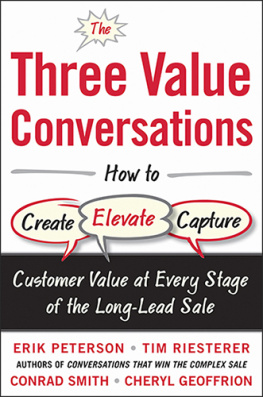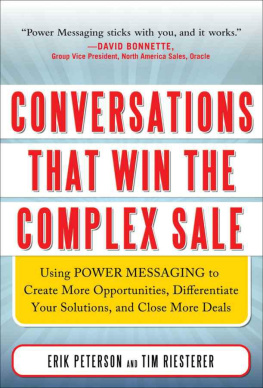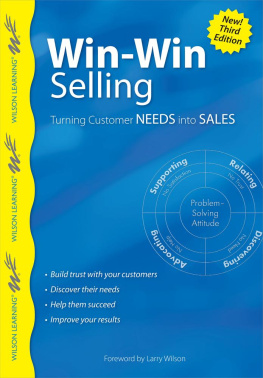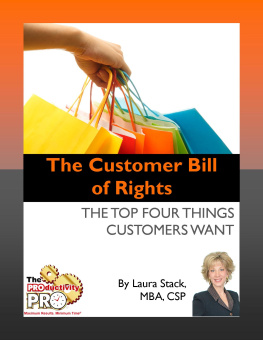If you enjoyed this book, discover your next great read with the following excerpt.
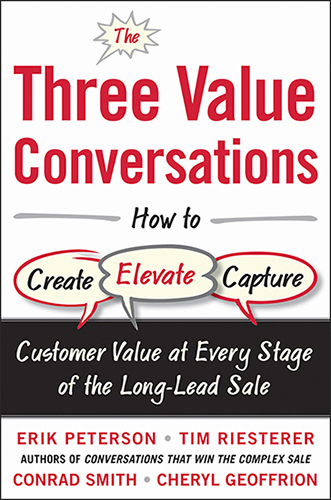
Create a Buying Vision
Researchers at the Corporate Executive Board, Sirius Decisions, and other analyst firms have recently tried to claim that buyers have completed 60 percent or more of their purchase cycle before they ever contact a salesperson. In other words, your prospects are doing the majority of their research, solution development, and vetting of competitors online, on their own, before you even get a chance to make your case. This has led some people to believe that salespeople are dead.
But theyre wrong. Consider these contradictory research findings.
Sales Benchmark Index indicates that nearly 60 percent of all qualified sales pipeline opportunities actually end up in no decision. In other words, the majority of the deals you are working on wont lead to anything different at the end of the process. In some industries, such as banking and insurance, sales leaders tell us that 80 to 90 percent of final presentations end up with the prospect sticking with the status quo.
If buyers insist that they are 60 percent done with the purchasing process before they want to talk to a salesperson, yet 60 percent of the time they make no decision (), you have to question the accuracy of their judgment.

Figure 1.1 Buyers believe that they are 60 percent or more done with the purchase cycle before they engage with a salesperson, insisting that they dont need salespeople until they are ready to buy.
But buyers actually make no decision in 60 percent or more of the qualified sales cycles, creating a question about how far along in the process they really are.
Declared Preference Versus Revealed Preference
So whats going on here?
Its important for you as a salesperson to understand a little bit of behavioral economics. This contradictory research phenomenon is referred to as declared preference versus revealed preference. This means people will say one thing when they have no money or reputation on the line, and then do the complete opposite when real money and reputation are at stake.
In this case, buyers think they are much further along the decision-making path when they are asked what they believe to be true about their intentions and behaviors. But, when push comes to shove and they have to actually do something, they cant pull the trigger.
So arguably, the majority of the buyers you encounter are still trying to decide whether or not they are willing to make a change, not whether they want you or a competitor.
Not in this case, you might be thinking. They called us! Theyve already said theyre looking to buy.
Yes, but. Thats still theoretical. When it comes down to it, many of them will postpone their decision or decide that something else more urgently needs fixing. Even if you think this client is totally aware of the need, you have to reinforce it.
Creating a Buying Vision
What this means for you is that despite what your buyers are telling you they want to hear, you need to have the patience to take a step back in the process and make sure that they have a true buying visionthat theyre convinced they can no longer stick with the status quo, they understand the needs and requirements they should be considering, they appreciate the urgency of the situation, and they know what capabilities and strengths they should be looking for.
And all this requires the assistance of a salesperson.
Forrester Research recently updated some ongoing studies it does regarding the buying habits of executive decision makers. One of the most telling results has to do with whether companies give their business to the salesperson who establishes the buying vision, or whether they put their decisions through a truly fair bake-off.
Turns out, 74 percent of executives indicated that they give their business to the company that establishes the buying vision. In other words, they choose to work with the company that helps them clearly see the need to change and helps them clarify their needs and solution requirements. That means that only 26 percent rely on a side-by-side competitive comparison to choose their winner ().

Figure 1.2 The percentage of executive buyers who admit they give their business to the salespeople who are in early and create the buying vision continues to go up.
This doesnt mean you wont have to go through a competitive process eventually, but it does validate the need to get in early with value conversations, instead of waiting for prospects to do all their homework without you. It also says you need to assume that most customers you engage are still on the left side of , trying to determine whether they need to do anything different, despite what they may be telling you. (Remember: declared preference versus revealed preference!)
Make the Status Quo Unsafe
Heres what most salespeople dont realize: Your biggest enemy is not your competitor. Your biggest enemy is the status quo. Behavioral scientists call this the status quo bias. Its looming there like a smiling monster, silently squashing the majority of sales conversations, no matter how good the presentations may be. Know why? Because the status quo hasnt killed them yet.
Even if your buyer is in some way dissatisfied with the status quo, its safe. Its known. There may be a problem with it, but the company has adapted and business has gone on. The buyer may even tell you that he wants to change and that hes ready to change, but when it comes right down to it, at least 60 percent of those buyers wont change after hearing from you and your competitorsat least not yet.
Its like the people who are still using AOL e-mail. At some point, they probably realized that they were getting ripped off by still paying for something they could get for free somewhere else, but they stick with the status quo because its what they know. Switching to a new e-mail provider is too scary. It means they have to learn a new interface, figure out how to import their contacts (or create a new address book), tell everyone theyve changed their e-mail address, and maybe lose all their saved e-mail. They dont really believe that they can get the same level of service (or better!) for free, so they keep paying. Theyve probably even started researching and looking around a few times, but theyve never finished making a decision about what to do.
Maybe you dont know anyone whos still using AOL, but do you know anyone whos still buying CDs for music? Even though she is paying for a lot of songs she doesnt like just to get the few she does? The pain of changing to a completely new music system seems way more painful than the pain of spending 70 to 80 percent of your music dollar on crappy music (based on a reasonable guess that most people like about 3 songs of the 12 on each CD they purchase).
Inertia is powerful!
The way to overcome this is by showing your contact that the status quo is unsafe. Its unacceptable, untenable, or unsustainable. Your contact has to see that he cant get there from here when it comes to his objectives and the risk created by sticking with the status quo.
Next page
